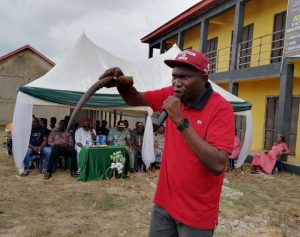Kaduna Nzeogwu & Co Did Not Start Nigeria’s Problem By Rudolf Ogoo Okonkwo
Unfortunately, our forefathers noted that those who did not know where the rain started to beat them would never know where it stopped.
On January 15 of every year, Nigerians remember what they were told was the most tragic incident that destroyed the ideal nation their founding fathers were building.
That was the day Kaduna Nzeogwu and his co-conspirators executed a coup that ended the First Republic. As horrific as the events of that day were, that was not where the water entered the husk of the melon.
This year, Senator Shehu Sani argued that Nigeria has yet to recover from the assassination of Sir Ahmadu Bello and others killed on that day. It is hard to quarrel with Sani’s perspective. Even for people like Sani, who were not born when the incident happened, those interested in ensuring they did not forget had etched the narrative into them.
It is a time-tested survival mechanism for humans to tell stories to younger generations to guide them in navigating their world. This ancient system of teaching the young about experiences started when our human forbearers were still living in trees.
Unfortunately, our forefathers noted that those who did not know where the rain started to beat them would never know where it stopped.
In the last few days, I have been recalling my conversations with the University of Ibadan-trained historian, Professor Chieka Ifemesia, who recently joined our ancestors. The core thesis of Ifemesia’s analysis of Nigeria’s malady was that “two ideas of nation-building have conflicted in Nigeria since amalgamation.” The clouds had been gathering since 1914, but it was in 1953 that the rain started to beat us, not in 1966.
By the year 1953, southern leaders were ready for Nigeria to become an independent nation. They were pushing for a three-year plan that would have granted Nigeria independence in 1956, one year before Ghana. The only problem was that the leaders of the North felt their region was not ready.
The North feared the South would dominate the new nation. As a result, the North argued for a delay. Their leaders believed that if given a few years, they could catch up on the number of northerners who had gone to school and were qualified to take part fully in governing Nigeria.
That was the country’s mood when, on March 31, 1953, Anthony Enahoro moved a motion at the Federal Parliament in Lagos for Britain to grant Nigeria independence by 1956.
Immediately, southern politicians in the Action Group and the National Council of Nigeria and the Cameroons (NCNC) joined him. The leaders of the North insisted on a gradual process. Ahmadu Bello proposed a compromise: the Enahoro bill should state self-government “as soon as possible” rather than “in the year 1956.”
The southern leaders’ insistence on 1956 led to all parties walking out of parliament, leaving the British colonial administrators in Nigeria at a loss as to whom to negotiate with.
As northern leaders left parliament, Lagos’ crowds jeered them on their way home. Northern leaders returned to Kaduna and issued a statement. In their 1953 statement from Lugard Hall in Kaduna, northern leaders listed eight points that the southern leaders had to meet before they would return to Lagos.
For all intents and purposes, the northern leaders were ready to leave the country. Southerners like Samuel Akintola, Anthony Enahoro, and other pro-independence politicians took their campaign for independence to the North.
That was how the riot of 1953 started.
On May 15, 1953, Northern People’s Congress supporters staged a demonstration to show Akintola and his team that they did not support their mission in the North.
The next day, Saturday, May 16, 1953, the Kano Native Authority withdrew the permission initially granted to Akintola and his group to hold their meeting at Colonial Hotel, Kano. Subsequently, mobs stormed the hotel and threw stones at Akintola and his fellow independence activists inside.
Initially, two people died. Then, the mobs moved to Sabon Gari.
By Sunday, May 17, it had escalated into a full-scale inter-ethnic crisis. The mobs chanted anti-Yoruba songs as they went on a rampage. British authorities called in the military to help quell the situation. By the time it was over, 46 people, mostly Southerners, were dead.
The day after the riot, the British colonial government imposed a state of emergency in Northern Nigeria before they regained control of the situation. The British administrative officers also conducted a probe. At the end of the probe, their statement read: “No amount of provocation, short-term or long-term, can in any way justify their behavior… the seeds of the trouble which broke out in Kano on May 16 (1953) have their counterparts still in the ground. It could happen again, and only a realization and acceptance of the underlying causes can remove the danger of recurrence.”
That was the crux of Nigeria’s problem. The British identified the existence of the seeds of the trouble that broke out in Kano on May 16, 1953. They warned it could happen again unless Nigerians realized and accepted the underlying causes.
Of course, Nigerians neither realized nor accepted the underlying causes. Meanwhile, the seeds in the ground continued to absorb water and oxygen as their embryo’s cells enlarged. Again, for emphasis, one underlying cause is Ifemesia’s argument: the two conflicting ideas of nation-building that have plagued Nigeria since amalgamation.
After the riot, Ahmadu Bello and the northern leaders in the NPC issued another list of demands. This time, they presented it as a condition for their return to the Federal Parliament in Lagos.
The demands of the northern leaders included safeguards ensuring regional autonomy. The negotiations for Nigeria’s unity went so well that Ahmadu Bello was comfortable staying in the North as Premier while he sent his protégé, Abubakar Tafawa Balewa, to Lagos to serve as Prime Minister.
This is the uncontested sketch of what happened in 1953.
However, the underlying causes of the 1953 riot in Kano were neither addressed nor accepted. And nobody uprooted the seeds of the trouble in the ground. When they manifested again in 1966, it was not just rain this time; it was thunder and hailstones.
Whether in 1953 or 1966, we understand that if there are two players in a story, there are at least three perspectives: one from each player and a third from a neutral observer. Finding a neutral observer is not as easy as it seems. Those who consider themselves victims often have more compelling stories. Those considered perpetrators also hold what they believe to be interesting narratives—if only anyone cares to listen attentively.
In most deeply devastating human events, different players at different times cross the line that separates victims from perpetrators. Even when history, the ultimate arbitrator, renders its verdict, it struggles to pinpoint the exact moment of no return—the moment when identifying and accepting the underlying causes could have prevented the tragedy.
As humans, we have continued to do the easy part—pointing fingers and apportioning blame—rather than the difficult part of working toward a solution to prevent a recurrence. And when history repeats itself, we blame our stars rather than our inaction.

Kaduna Nzeogwu & Co Did Not Start Nigeria’s Problem: A Reflection on Nigeria’s Struggles and the Seeds of Division by Rudolf Ogoo Okonkwo
Kaduna Nzeogwu & Co Did Not Start Nigeria’s Problem: A Reflection on Nigeria’s Struggles and the Seeds of Division by Rudolf Ogoo Okonkwo
EXCERPT
Source: SR




